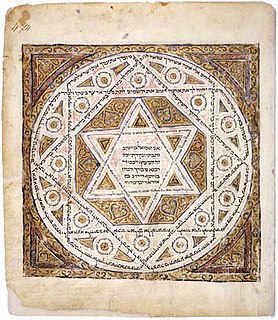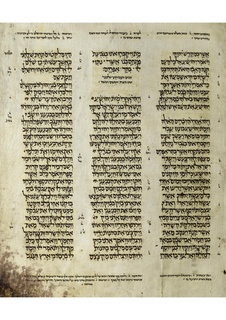Related Research Articles

The Greek Old Testament, or Septuagint, is the earliest extant Greek translation of books from the Hebrew Bible. It includes several books beyond those contained in the Masoretic text of the Hebrew Bible as canonically used in the tradition of mainstream Rabbinical Judaism. The additional books were composed in Greek, Hebrew, or Aramaic, but in most cases, only the Greek version has survived to the present. It is the oldest and most important complete translation of the Hebrew Bible made by the Jews. Some targums translating or paraphrasing the Bible into Aramaic were also made around the same time.

The Masoretic Text is the authoritative Hebrew and Aramaic text of the 24 books of the Hebrew Bible (Tanakh) in Rabbinic Judaism. The Masoretic Text defines the Jewish canon and its precise letter-text, with its vocalization and accentuation known as the mas'sora. Referring to the Masoretic Text, mesorah specifically means the diacritic markings of the text of the Hebrew scriptures and the concise marginal notes in manuscripts of the Tanakh which note textual details, usually about the precise spelling of words. It was primarily copied, edited and distributed by a group of Jews known as the Masoretes between the 7th and 10th centuries of the Common Era (CE). The oldest known complete copy, the Leningrad Codex, dates from the early 11th century CE.

According to the Hebrew Bible, the Tribe of Simeon was one of the twelve tribes of Israel. The Book of Judges locates its territory inside the boundaries of the Tribe of Judah. It is usually counted as one of the ten lost tribes, but as its territory was south of Judah and gradually being absorbed by Judah, it can not be considered one of the tribes of the Kingdom of Israel and would certainly not have been affected by the Assyrian sack of the kingdom.

The Negev or Negeb is a desert and semidesert region of southern Israel. The region's largest city and administrative capital is Beersheba, in the north. At its southern end is the Gulf of Aqaba and the resort city and port of Eilat. It contains several development towns, including Dimona, Arad and Mitzpe Ramon, as well as a number of small Bedouin towns, including Rahat and Tel Sheva and Lakiya. There are also several kibbutzim, including Revivim and Sde Boker; the latter became the home of Israel's first Prime Minister, David Ben-Gurion, after his retirement from politics.

Beersheba or Beer Sheva, officially Be'er Sheva, is the largest city in the Negev desert of southern Israel. Often referred to as the "Capital of the Negev", it is the center of the fourth-most populous metropolitan area in Israel, the eighth-most populous Israeli city with a population of 209,687, and the second-largest city in area, with a total area of 117,500 dunams.
Shishak, Shishaq or Susac was, according to the Hebrew Bible, an Egyptian pharaoh who sacked Jerusalem in the 10th century BCE. He is usually identified with the pharaoh Shoshenq I.

The chapter and verse divisions did not appear in the original texts; they form part of the paratext of the Bible. Since the early 13th century, most copies and editions of the Bible present all but the shortest of these books with divisions into chapters, generally a page or so in length. Since the mid-16th century, editors have further subdivided each chapter into verses – each consisting of a few short lines or sentences. Esther 8:9 is the longest verse in the Bible. Sometimes a sentence spans more than one verse, as in the case of Ephesians 2:8–9, and sometimes there is more than one sentence in a single verse, as in the case of Genesis 1:2.

Matthew 2:18 is the eighteenth verse of the second chapter of the Gospel of Matthew in the New Testament. Herod has ordered the Massacre of the Innocents and this verse quotes from the Book of Jeremiah to show that this event was predicted by the prophets.
Ramah may refer to:

Judges 1 is the first chapter of the Book of Judges, the seventh book of the Hebrew Bible or Old Testament, a sacred text in Judaism and Christianity. With the exception of the first verse, scholars have long recognised and studied the parallels between chapter 1 of Judges and chapters 13 to 19 in the preceding Book of Joshua. Both provide similar accounts of the purported conquest of Canaan by the ancient Israelites. Judges 1 and Joshua 15–19 present two accounts of a slow, gradual, and only partial conquest by individual Israelite tribes, marred by defeats, in stark contrast with the 10th and 11th chapters of the Book of Joshua, which portray a swift and complete victory of a united Israelite army under the command of Joshua.
Meir ben Todros HaLevi Abulafia, also known as the Ramah, was a major Sephardic Talmudist and Halachic authority in medieval Spain.

David's Mighty Warriors are a group of 37 men in the Hebrew Bible who fought with King David and are identified in 2 Samuel 23:8–38, part of the "supplementary information" added to the Second Book of Samuel in its final four chapters. The International Standard Version calls them "David's special forces".

There is no scholarly consensus as to when the Hebrew Bible canon was fixed. Some scholars argue that it was fixed by the Hasmonean dynasty, while others argue it was not fixed until the second century CE or even later.
"They have pierced my hands and my feet", or "They pierced my hands and my feet" is a phrase that occurs in some English translations of Psalm 22:16. The text of the Hebrew Bible is obscure at this point, and Jewish and some Christian commentators translate this line differently, although there is no evidence of a deliberate mistranslation.
Moladah was a biblical town of Simeon in the Negeb near Beersheba.
Menois, a small town near Gaza in the Roman province of Palaestina Prima, is mentioned by Eusebius of Caesarea and other sources of the first millennium AD. Eusebius identified Menois with two places mentioned in the Old Testament of the previous millennium. One is the town in the Book of Joshua that in English is usually called Madmannah. The other is the Book of Isaiah's Madmenah. Neither of these identifications is unanimously accepted by modern scholars. Menois is believed to have been situated some 20 kilometres south of Gaza. For those who suppose Madmenah to have been to the north of Jerusalem this rules out its identification with Menois.

Habakkuk 2:4 is the fourth verse of the second chapter of the book of Habakkuk. Habakkuk 2:4 was quoted by the Apostle Paul in the book of Romans and Galatians, it also became one of the most important verses that were used as foundations of the doctrines of the Protestant reformation.
The Book of Joshua lists almost 400 ancient Levantine city names which refer to over 300 distinct locations in Israel, the West Bank, Jordan, Lebanon and Syria. Each of those cities, with minor exceptions is placed in one of the 12 regions, according to the tribes of Israel and in most cases additional details like neighbouring towns or geographical landmarks are provided. It has been serving as one of the primary sources for identifying and locating a number of Middle Bronze to Iron Age Levantine cities mentioned in ancient Egyptian and Canaanite documents, most notably in the Amarna correspondence.

The Arad ostraca, also known as the Eliashib Archive, is a collection of more than 200 inscribed pottery shards found at Tel Arad in the 1960s by archeologist Yohanan Aharoni. Arad was an Iron Age fort at the southern outskirts of the Kingdom of Judah, close to Beersheba in modern Israel.
References
- ↑ Na'aman, Nadav (1980). "The Inheritance of the Sons of Simeon". Zeitschrift des Deutschen Palästina-Vereins. 96 (2): 136–152. JSTOR 27931137.
- ↑ Edelman, Diana (1988). "Tel Masos, Geshur, and David". Journal of Near Eastern Studies. 47 (4): 253–258. doi:10.1086/373319. JSTOR 544878. S2CID 161665896.
- ↑ Aharoni, Yohanan (1970). "Three Hebrew Ostraca from Arad". Bulletin of the American Schools of Oriental Research (197): 16–42. doi:10.2307/1356384. JSTOR 1356384. S2CID 163480681.